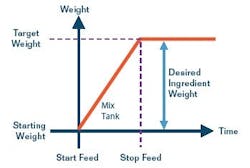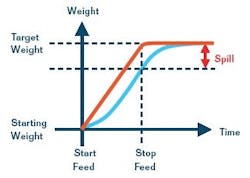Getting batch material transfers under control
By Charlie Fu, Ph.D., Technology Leader, Procter & Gamble Company
THE MAIN GOAL of controlling batch material transfers is to feed the exact amount of material in the shortest time—except for some cases such as flow ratio control, etc. As we’ll see, this isn’t always so easily accomplished, and we’ll explain why and what you need to make material transfers flow as quickly and accurately as possible.
From a control point of view, speed and accuracy seem mutually exclusive in batch-transfer applications. In an ideal situation, a constant material flow rate with no variations is easy to control. But try finding a flow with no variations. Flow variations can result from differences in material characteristics, changes in process equipment and dynamic characteristics, and inconsistency in control system execution time.
Any or all of all these variations would have a deleterious impact on determining when a stop-feed command should be issued to a materials flow. Why? Consider a weight scale-based batch material transfer. It is almost certain that stopping the feed when the scale reading equals setpoint or target amount will not result in the exact amount of material to be delivered, or lead to the “ideal” curve in red shown in Figure 1 (Click the Download Now button below to see a .pdf version of the figures referred to in this article). The inexact quantity of delivered material is due to spill, as shown in Figure 2. Spill is the difference between final material added and measuring-device reading at the time when a command is issued to stop the feed.
A real-world feed curve is more like the curve shown in blue in Figure 2 (Click the Download Now button below to see a .pdf version of the figures referred to in this article). Due to the spill, the dynamic scale reading differs from final weight at any moment during feed; in particular, the moment of cutoff. Cutoff means an action when a command is issued to stop the feed. More complicated is that spill normally results from compound effects. The most important effects are:
Material in suspension—A portion of the material that has passed through the valve can still be in “free-fall” and has not yet reached the surface of the mix. A spill amount of material in suspension depends on the distance between the surface of the mix in the receiving vessel (weight-scale based) and its final control element, such as a valve.
Deceleration force—The dynamic force or kinetic energy adds to the scale reading until the material flow has stopped. Magnitude of deceleration force is related to the feed speed, which varies.
Scale/Filter lag—During a feed, the scale reading at any moment can “lag” the actual weight on scale when filtering has been applied to dampen vibration because of agitators or other process components. Regardless of the type of filtering (mechanical, electrical or digital), the scale weight discrepancy will increase the lag.
Command lag—Some delays always exist between the time when a cut-off command is given and the time at which the command acts on the final control elements. Command lags can be related to architecture of the control system (controller, final control element, and measuring device), structure of the program logic in the controller, and scan/update rates of all the components associated with the material transfer.
Valve “let-through”—Valves can’t be closed instantaneously. Conveyors don’t stop instantly. Some material passes through while the device is closing/shutting down. A spill depends on reaction time and consistency of the final control element, which may vary from batch to batch.
The reality is that spill is inevitable and cannot be measured in real time. To shut off the material flow at the right time, a spill has to be predicted correctively in advance. While we may be able to use historical data to calculate a previous spill for a certain delivery speed, it is hard to get very accurate data for calculations to make predictions. Since spills usually vary from batch to batch, even with the same material, how can we minimize system variations for spills to be predictable? What information is important and should be collected to make good spill predictions? Answers to these questions result from good control system designs and implementations.
Usually, it’s relatively easy to make a good cutoff with good accuracy if flow rate is low. However, material transfer at a low flow rate slows down the process, which has a negative impact on batch cycle time and productivity. To reduce the impact, multi-speed feeders are used in many applications today. But the multi-speed feed approach cannot run at full speed for the entire course of material transfer because it would still have some negative impact on batch cycle time. Also, using a multi-speed feed approach increases complexity in construction, system engineering and maintenance.
Therefore, a good control strategy for batch material transfers relies heavily on spill predictability to have fast and accurate feed controls. It is not a trivial task, however, to develop a practical algorithm for good spill prediction and controls.
In addition to the spill calculation/prediction, there are many more important functions for batch material transfers that should be built into control systems.
Where to build those functions in a batch control system?
If having some or all the functions described in the three boxes can be aligned among operational, process engineering and system control organizations, a decision must be made as to where to build these functions. A quick answer to this question might be in controllers where all the phase, equipment module and control module logic reside.
Most P&G batch control systems have had many of these functions built in to the controller level for more than 30 years. We realized the main advantage to this solution is that users can see the code for the functions, and create, develop and modify them without too much restriction. Disadvantages of this solution become also obvious:
- These functions occupy a lot of memory space in the controller(s).
- Users have to maintain the code.
- It is a platform-dependent solution since controllers are platform dependent.
Today, it makes sense to locate these functions in field devices, which can be scales or flowmeters where material transfers are measured. However, building these functions in field devices requires a strong commitment from associated vendors, which may not be easy to obtain. On the contrary, having these functions built into industrial controllers can be done at the user’s wish.
It seems that many of the disadvantages will disappear and more advantages will surface when some of these functions are built into field devices. With controls built into the field device, variations such as logic scan rate and command paths can be minimized. Since building and maintaining the code for these functions requires good technical skills, it may or may not be cost-effective to keep all skills “in house” for a long term. If, however, users do not want to know how the functions are coded and do not want to maintain the code for modification, troubleshooting and upgrades, having most of the functions built into field devices can be a good solution.
P&G recently has upgraded several manufacturing batch systems with some field devices containing most of the functions for material transfers. Experience with this technique has been very positive. Not only do functions in the field devices meet all our speed and accuracy requirements, but the size and complexity of the program in the controller have been significantly reduced.
Conclusion
Batch material transfer control seems an easy task to carry out. But the reality is that many functions are necessary if the system is to accomplish accurate batch material transfer control. Most functions for batch material transfer controls can be built in either industrial controllers or field devices. While building some of these functions into the controllers can be managed by the users, in field devices, it requires commitment and support from vendors. Either way has its advantages and disadvantages in engineering, maintenance, and supportability.
(Editor’s Note: This article is based on a paper, “Functions Ned to be Cosidered for Batch Material Transfer Controls,” given at the World Batch Forum, Chicago, IL (2004). For more information on the World Batch Forum, go to www.wbf.org.
References
- Mettler Toledo Inc., “Predictive Adaptive Control Applied to Material Transfers in Batch Processes,” presented at World Batch Forum 2002.
- Chappell, Dave, “Predictive Material Delivery to A Batch System,” presented at World Batch Forum 2002.
| About the Author |
Charlie Fu is technology leader in the Corporate Engineering Technology, Department of Power, Control & Information Technologies, Procter & Gamble Company, West Chester, OH.



